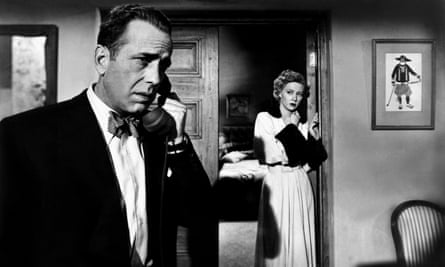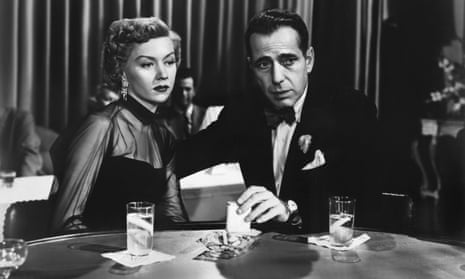Humphrey Bogart’s world-weariness and romanticism take on something brutal and misogynist in this 1950 noir masterpiece directed by Nicholas Ray – and it’s a marvellous performance by Gloria Grahame. This national rerelease is linked to the Grahame retrospective at BFI Southbank, in London. It is adapted from the hardboiled thriller by Dorothy B Hughes, changing her story and rehabilitating the male lead in one way, but in another, introducing a new strain of pessimism and defeat.
Bogart is Dixon Steele, a boozy, depressive Hollywood screenwriter whose tendency to violence and self-hatred isn’t helped by the fact that he hasn’t had a hit in years. Like the directors, producers and actors he occasionally sees in bars, his best days were before the second world war. One night at a restaurant, his agent offers him a much-needed gig adapting some brainless bestseller and Dix shruggingly accepts. The wide-eyed hatcheck girl, Mildred (Martha Stewart), tells him she loves the book and, amused, Dix invites her back to his place to tell him what it’s all about. Having established his intentions are gentlemanly, Mildred agrees.
Whatever Dix’s intentions may actually have been, they are blown out of the water when the pair of them run into his new neighbour as he is about to show Mildred across the threshold – on her way back to her own apartment. This is Laurel (Grahame), who is wryly amused by what she clearly sees as Dix’s clumsy, predatory designs on this poor girl. Dix is intensely chagrined, and somehow falls for the beautiful, elegant Laurel in that instant. And when that evening later takes a terrible turn for Mildred, Laurel saves Dix from police suspicion by giving him an entirely honest and accurate alibi. They begin to date, but his own propensity to violence scares her, and then she hears how he once broke his ex-girlfriend’s nose. Could Dix be the psychotic killer that the police are looking for, the one who murdered Mildred?
Bogart was 50 when the picture was made, and Grahame was 27, and yet the age difference between them doesn’t seem as great because of Grahame’s remarkable confidence, maturity and charisma. She is midway between Mae West and Marilyn Monroe: stylish, sexy and self-possessed. Bogart’s performance is daring: it is precisely his cynicism and what-the-hell attitude to everything that has put him in the frame for the murder, and there is something sociopathic about the way he never quite drops this tone. He has a habit of making wasteful gestures of pseudo-remorse, sending flowers to the dead woman’s address, and cash to a young kid he beats up after a road-rage incident.

When he comes to dinner with his old army buddy Brub (Frank Lovejoy), now a cop investigating the case, there is something very creepy in the way he imagines for their benefit how the killer would have behaved with his victim, using what he complacently announces is his imaginative and creative expertise: “I’ve killed dozens of people in pictures!” Bogart’s face loses all its ruined handsomeness as he becomes overexcited about the murder: he becomes wizened and rat-like and his crooked teeth protrude gruesomely.
As befits a film about a screenwriter, the film is intriguingly self-aware. “A good love scene should be about something aside from love,” Dix tells Laurel. He says it just after he has to admit to having embarrassingly straightened out a grapefruit knife that was supposed to be curved. Could it be that we are supposed to catch an echo of James Cagney’s grapefruit-related violence from The Public Enemy (1931)? So maybe Dix didn’t do it, but this case is revealing other ways in which he is hopelessly guilty about everything else. A captivating noir classic.

Comments (…)
Sign in or create your Guardian account to join the discussion